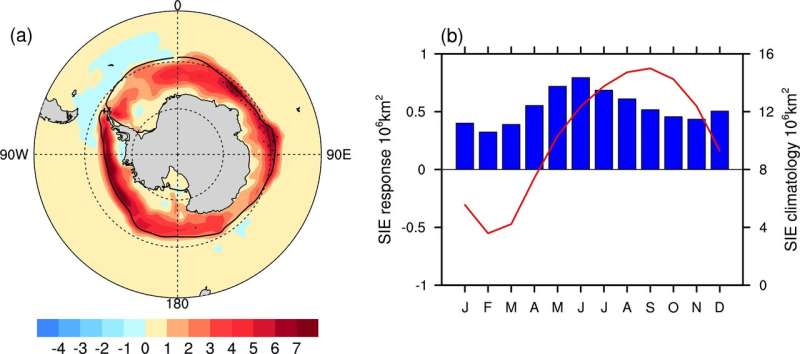Plugging the ozone hole has indirectly helped Antarctic sea ice to increase

A new study demonstrates that the recovery of the Antarctic Ozone Hole causes decreases in clouds over Southern Hemisphere (SH) high latitudes and increases in clouds over the SH extratropics. The decrease in clouds leads to a reduction in downward infrared radiation, especially in austral autumn. This results in cooling of the Southern Ocean surface and increasing Antarctic sea ice.
Observational records show that stratospheric ozone declined prior to the late 1990s, and an abrupt 50% reduction in the Antarctic stratospheric ozone layer occurred during September to November each year, the result of which is commonly known as the 'ozone hole'. Since then, stratospheric ozone started to stabilize, and has even slowly increased in the early part of the 21st century, especially in the polar regions.
Sea ice in the polar regions plays an important role in the global climate system. Change in sea ice results in a large variation in albedo over the sea surface, which leads to change in the absorption of solar radiation and the sea surface temperature. But how does the ozone layer, which is located in the stratosphere, influence Antarctic sea ice? This is a hot topic in the field of atmospheric science.
Recent studies demonstrate that the Antarctic ozone hole has important influences on Antarctic sea ice. For instance, ozone-induced changes in atmospheric and oceanic circulations significantly alter the transport of ocean heat and the dynamics of sea ice, consequently impacting upon sea surface temperatures and the Antarctic sea ice. Prof. Yongyun Hu and his team—a group of researchers from the Laboratory for Climate and Atmosphere-Ocean Studies, Department of Atmospheric and Oceanic Sciences, School of Physics at Peking University—have found that stratospheric ozone-induced indirect radiative effects also play important roles in causing changes in Antarctic sea ice, and their work has been accepted into the evolving special issue of Advances in Atmospheric Sciences on Antarctic Meteorology and Climate: Past, Present and Future.

By using a climate model, Prof. Yongyun Hu and his team designed a series of sensitivity experiments and found that ozone recovery leads to an increase in Antarctic sea ice.
"In this study, the atmospheric GCM was coupled only with a slab ocean to distinguish ozone-induced cloud radiative effects on sea ice, in which ocean heat transports and dynamic sea ice were excluded," says the corresponding author of the study, Prof. Hu. "Thus, the change in Antarctic sea ice is the product of radiation and heat processes. It is the indirect radiative effect of the stratospheric ozone change instead of its direct radiative effect that causes the changes in the sea surface temperature and sea ice. The indirect radiative effect comes from the change in clouds."
Their research demonstrates that the recovery of the Antarctic ozone hole absorbs more solar radiation and heats the lower stratosphere over the Southern Hemisphere high latitudes, which causes increases in the static stability in the upper troposphere and decreases in cloud cover over the Southern Hemisphere high latitudes. The reduced cloud cover leads to an increase in outgoing longwave radiation and a reduction in downward infrared radiation, especially in austral autumn. This results in cooling of the Southern Ocean surface and increasing Antarctic sea ice. Surface cooling also involves ice-albedo feedback. Increasing sea ice reflects solar radiation and causes further cooling and more increases in Antarctic sea ice.
More information: Advances in Atmospheric Sciences, DOI: 10.1007/s00376-019-8251-6 , www.iapjournals.ac.cn/aas/en/a … 07/s00376-019-8251-6
Provided by Chinese Academy of Sciences



















